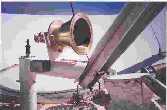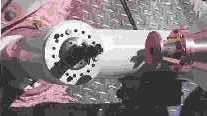New
feed mounts, installed 13 Mar 2002.
Mount design & construction by Steve Aragon
and Jon Thunborg; pictures by Kelly Gatlin
The beam
mount used till now for the 25m antenna signal path was heavy; allowed
only 2 subreflector rotations to be mapped; and required holes drilled
in the feed-cone roof. The new mount uses a central pillar with cantelever
to shorten and lighten this hardware, and allows positioning every
20deg around the feed circle.
The reference
horn was on the quadrupod leg, where cables were short but the lever arm
for converting pointing errors to phase offsets was 6.2m. Now
it sits behnd the subreflector <1m off axis, at the expense
of 15m more cable.
|
Thumbnail.
|
Description
|
 |
Shot from ground, loking into dish which is tipped down.
Reference horn is 1m away from the axis, (at top right) just outside
the rotating drum that holds the subreflector - see last picture
Signal path for main antenna (horn+mirror above feed cone) is
pretty much the same as before, except for the rotatable mount - see next
2 pictures
|
 |
New rotatable mounting arrangement, note laser pointer
(black finger poking up) to align the mount with antenna axis.
A similar laser mounts in the horn throat, and reflects off a bit
of (optical) mirror taped to the RF mirror to align the horn axis on the
cross hairs of the subreflector. The typical colimation offsets
for this feed are a few arcmin, not much more than those of the regular
VLBA bands. Rotation and focus must be re-found if the
mirror is rotated, and probably should be verified each time regardless. |
 |
Top view of mount - holes every 20deg.
The orientation (linear polarization angle) of the LNA must be rotated
for each position used around the feed circle to receive the linear
polarization emitted by the satellite beacon (12.198GHz, vertical polarization
at parallactic angle -10deg for the GE-4 satellite) |
 |
Reference horn position is now at the apex behind subreflector.
To align, put antenna at elevation=90 and use a spirit level on top
face. Note that the amplifier orientation and
feed alignment need not be adjusted once they are optimized for
a given satellite. |